di Giovanni
Ciceri -
www.argentinglesi.com
(click on photos to enlarge images)
BRITISH AND IRISH COMMEMORATIVE HALLMARKS
(- part 2 -)
A number of hallmarks are struck on silverware crafted in Great Britain and Ireland to
certify the fineness of silver (lion passant, crowned leopard head, thistle, lion rampant,
crowned harp), the place and date of hallmarking (Assay Office hallmark and date letter),
the payment of the duty on silver to the Royal Crown (the sovereign head and the Hibernia).
All these hallmarks are or have been compulsory (at least till the turn of last century), with
some exceptions for little items approved from time to time. More detailed information about the
silver and gold hallmarking in Great Britain and Ireland can be found at the following link
http://www.argentinglesi.com/marchi-garanziaing.php
Since 1935 a number of hallmarks (usually optional ones) have been approved and struck on
silverware to commemorate some important events such as the sovereign coronation and jubilee,
historical anniversaries, the new millennium, etc.
British and Irish commemorative silver pieces represent a sector of collection very
interesting for their historical implications, mainly related to the British
monarchy. The items bearing commemorative hallmarks are often very fine replicas of ancient and
historical pieces.
Commemorative items have obviously been crafted also before 1935 and in this case no dedicated
hallmarks can be found on them.
The following examples refer to commemorative silverware with both no dedicated hallmarks and
bearing commemorative hallmarks
GREAT BRITAIN AND UNITED KINGDOM
COMMEMORATIVE SILVERWARE WITHOUT SPECIFIC HALLMARKS
Before 1935 (in a few case also after this date), no dedicated commemorative hallmarks have
been used alongside the compulsory ones. To commemorate historical events like sovereign
coronation and jubilees, only inscriptions and or enamelled, embossed or engraved relevant
pictures have been used, mainly on items like spoons, goblets, salvers and plates. A particular
item used to commemorate the sovereign coronation was the replica of the
"anointing spoons" .
They are replica of an original silver-gilt spoon set with pearls displayed with the Crown
Jewels at the Tower of London alongside the ampulla (a hollow gold vessel shaped like an eagle).
It was probably made for Henry II or Richard I and it is the only piece of royal goldsmith's
work to survive from the 12th century. During the coronation ceremony, when the Archbishop of
Canterbury anoints the Sovereign, the anointing oil is poured from the ampulla into the
anointing Spoon.
|
The following samples are taken from private collections.
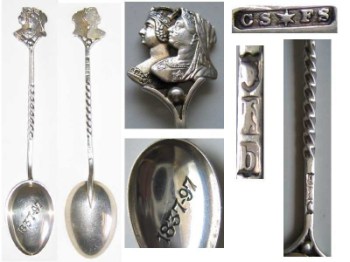 |
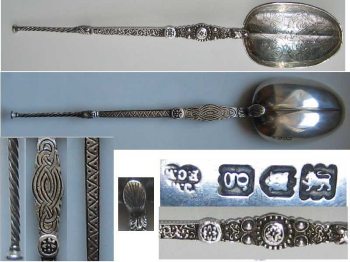 |
Diamond Jubilee of the Reign of Queen Victoria. (spoon)
Cornelius Desormeaux Saunders e James Francis Hollings Shepherd, London 1897.
The spoon bears at the top of the handle two portraits of a young (1937) and an aged (1897) Queen
Victoria.
Dimension and weight: 11.7 cm, 12 g.
|
Coronation of Edward VII (anointing spoon)
James Wakely e Frank Wheeler, London 1902.
These spoons are usually the size of a dessert or of a teaspoon and are gilt. This is a rare
example of a "not gilt" one having the dimension of a serving spoon.
Dimension and weight:: 25.7 cm, 98 g.
|
|
|
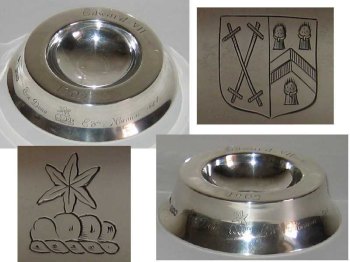 |
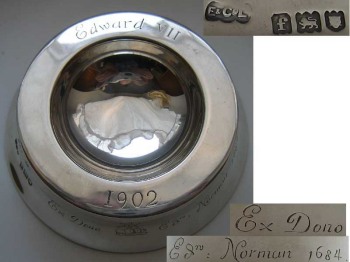 |
Coronation of Edward VII (salt cellar)
Elkington & Company, London 1901/1902. This is a replica of a 17th century salt cellar, as
results from a written card accompanying the item. It reports some engraved inscriptions and
decorations:
- Edward VII and 1902, in commemoration of the sovereign coronation in 1902;
- Ex dono (Latin for "coming from a donation") and "E & tv = Norman
1684", probably already engraved on the piece taken as model;
- A couple of coat of arms, probably already engraved on the piece taken as model.
Dimension and weight: 3 cm high; max section 3 cm, 129 g.
|
|
|
|
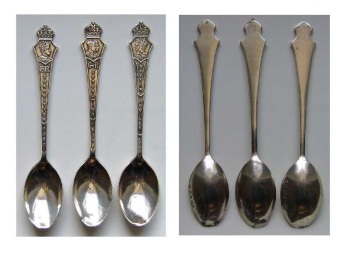 |
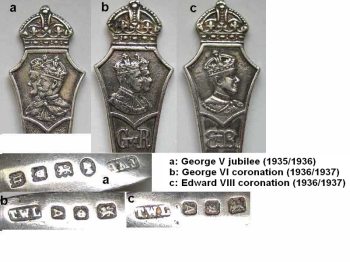 |
Coronation of Edward VIII and Coronation of George VI (teaspoons)
Maker TWL, London 1936/1937
The spoon commemorating the coronation of Edward VIII (above right: c), reports
at the top of the handle the profile of the sovereign and the inscription "Coronation 1937".
The spoon commemorating the coronation of George VI (right: b), reports at
the top of the handle the profile of the sovereign and his wife Queen Elisabeth (the Queen
Mother) and the inscription "Coronation 1937"
Dimension and weight: 2.5 cm, 17-18 g.
|
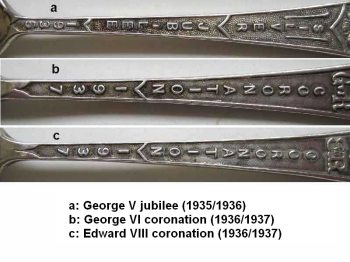 |
|
|
Marriage of Queen Elisabeth II and Philip of Edinburgh (salver or plate)
Comyns, London 1972, limited and numbered edition.
Dimension and weight: 23 cm, 382 g.
|
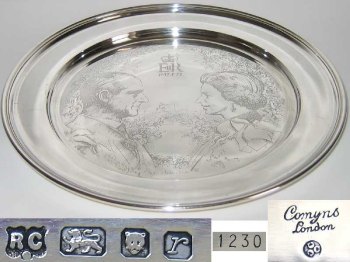 |
|
|
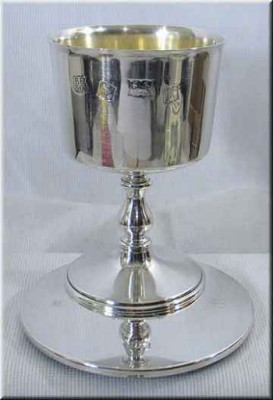 |
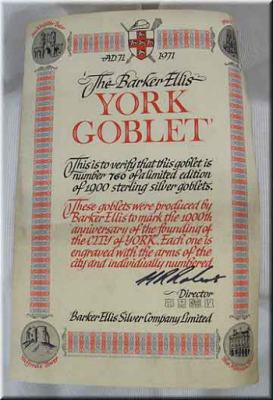 |

1900th anniversary of the founding of the City of York (Goblet and coaster)
Barker Ellis Silver Company, Birmingham 1970/71. Limited edition.
Goblet and coaster made to commemorate the 1900th anniversary of the founding of the City of
York in AD71. Like the ancient items, the side of the bowl carries a randomly impressed and
oversized set of British sterling silver hallmarks for Birmingham 1970/71. On both items the
coat of arms of the City of York is engraved between the dates AD71 and 1971.
The scrolled certificate of authenticity has been hand inscribed with the number of the goblet
(760 over 1900, like the years of the anniversary) and bound with a red ribbon.
Dimension and weight: goblet: 11 cm high, 7.5 cm section, 145 g; coaster: 10 cm section, 97 g.
|
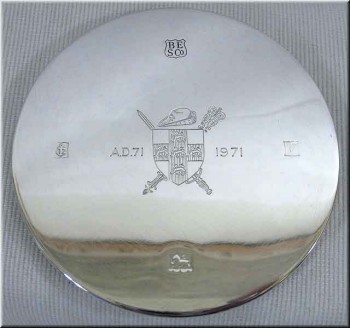 |
|
|
|
GREAT BRITAIN AND UNITED KINGDOM
COMMEMORATIVE SILVERWARE WITH SPECIFIC HALLMARKS
Items having commemorative hallmarks are more interesting from a collecting point of view.
A commemorative hallmark was first introduced in 1935 on the occasion of the silver jubilee of
George V. The mark reproduces the profiles of King George V and Queen Mary.
This example was replicated in 1952 (Coronation of Queen Elisabeth II), 1977 (silver Jubilee of
Queen Elisabeth II) and 2002 (golden Jubilee of Queen Elisabeth II) with hallmarks reproducing
the profile of the Queen, but different from one to another.
Coronation and Jubilee hallmarks should not be confused with duty marks, also reproducing the
sovereign profiles, but in use only between 1784 and 1890.
In 1973, to commemorate the bicentenary of the Birmingham Assay Office, the Birmingham hallmark
(anchor) was struck bearing two C (two hundred in Roman numbers) one at each side of the anchor.
In the same year, the bicentenary of the Sheffield Assay Office was commemorated by impressing
the same date letter used in 1773 (a capital gothic E).
This produced a discontinuity in the date letter succession of the series starting from 1968
with two consecutive capitals E (the first one in cursive and the second in gothic). This date
letter series ends with a G (for the year 1974) because since 1975 a new symbol for the
Sheffield Assay Office was adopted (the "Tudor rose" subsituted the "crown")
and a new series of date letter was then started (ENDNOTE 1). This can result in some
difficulty in discriminating modern hallmarks for 1973 from the ancient 1773 hallmarks
(very rare and sought after by collectors)
(compare the hallmarks).
In 1935 and 1952, on the occasion of the use of the Coronation some English manufacturers produced
six spoons sets bearing each one a different hallmark of one of the six Assay Offices then active in
the UK (London, Birmingham, Sheffield, Chester, Edinburgh and Glasgow). This was not possible in
occasion of the Silver and Golden Jubilee of Queen Elisabeth II, because at that time only four Assay
Offices were still active (Chester closed in 1962 and Glasgow in 1964).
The last commemorative hallmark to be mentioned is the Millennium mark, struck on silver items
assayed in 1999 and 2000 and consisting in a cross with the number 2000 and a dot on its centre.
The bottom page table illustrates, in chronological order, the commemorative hallmarks used in
the United Kingdom between 1935 and 2002.
|
The photos below, obtained by items belonging to
"private collections", illustrate all the commemorative hallmarks used between 1935 and 2002.
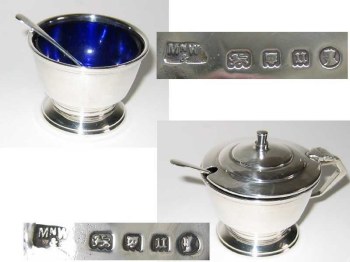 |
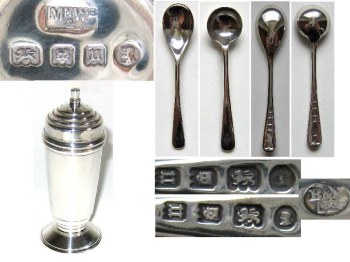 |
King George V Jubilee (cruet set)
Mappin & Webb (the spoons are marked MN&WB e B&F Ltd), London 1935.
The commemorative hallmark is the profile of King George V and Queen Mary.
Dimension: pepper 9 cm high, max section 3.8 cm: salt cellar 4 cm high, 5.5 cm section; mustard
pot 6 cm high, 7.5 cm section; salt spoon 5.5 cm; mustard spoon 6 cm.
Weight: pepper 46 g; salt 36 g; mustard pot 61 g; salt spoon 4g; mustard spoon 5g.
|
|
|
|
King George V Jubilee (teaspoon)
Maker TWL, London 1935.
The commemorative hallmark is the profile of King George V and Queen Mary. The spoon
(see on the left: photo a), reports at its top the head of King George V and Queen Mary and the
inscription "Silver Jubilee 1935".
Dimension and weight: 2.5 cm, 17 g.
|
 |
|
|
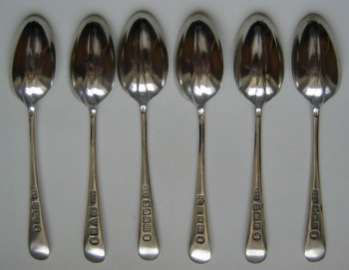 |
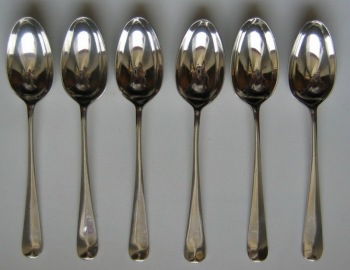 |
King George V Jubilee (set of six teaspoons)
Robert & Belk, London, Birmingham, Sheffield, Chester, Edinburgh and Glasgow, 1935. The
commemorative hallmark is the profile of King George V and Queen Mary. Note the difference in
maker marks registered at the six Assay Offices.
Dimension and weight: 11 cm, 81 g (overall weight).
|
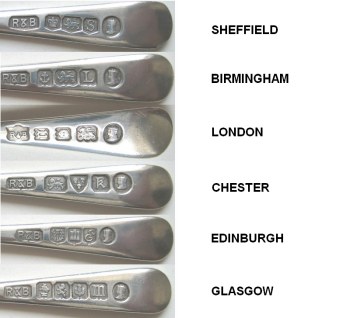 |
|
|
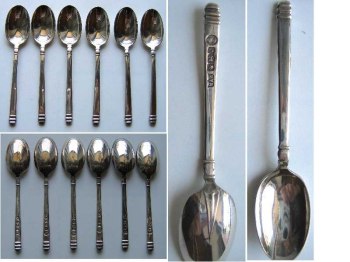 |
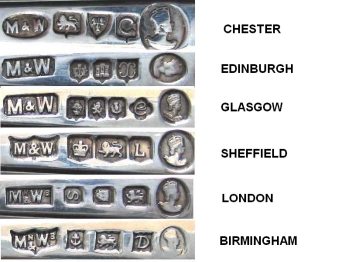 |
Queen Elisabeth II Coronation (set of six teaspoons)
Mappin & Webb, London, Birmingham, Sheffield, Chester, Edinburgh and Glasgow, 1953.
The commemorative hallmark is the head of Queen Elisabeth II. Note the difference in maker
marks registered at the six Assay Offices.
Dimension and weight: 10.5 cm, 72 g (overall weight).
|
|
|
|
Bicentenary of the Birmingham Assay Office (butter shell)
Maker DH & S, Birmingham 1973. The Birmingham hallmark (anchor) bears "CC" (two hundred in
Roman number) one at each side of the anchor.
Dimension and weight: 135 x 11.5 x 4.5 cm high, 121 g.
|
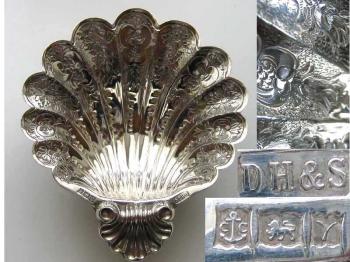 |
|
|
Bicentenary of the Sheffield Assay Office (table fork)
Maker G & H, Sheffield 1973. This date letter was first used in 1773.
Dimension and weight: 20.5 cm, 72 g.
|
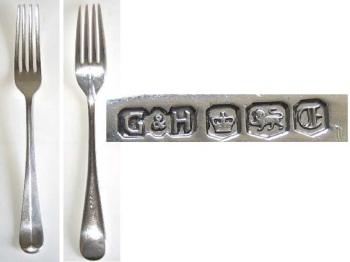 |
|
|
Queen Elisabeth II Silver jubilee (salver or plate)
Maker HC, London 1977, limited and numbered edition.
The commemorative hallmark is the profile of Queen Elisabeth II.
Engraved on the salver is the he Royal Coat of Arms of the United Kingdom, with the motto of
the British monarch, first adopted by Henry V (1413-1422), "Dieu et mon droit" (
French for "God and my right")(ENDNOTE 2). Also engraved "Royal Silver
Jubilee" and the dates "1952-1977", for the
Silver Jubilee after the Coronation of 1952.
Dimension and weight: 25.5 cm, 402 g.
|
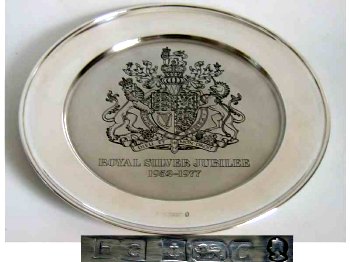 |
|
|
Queen Elisabeth II Silver Jubilee (replica of an antique apostle spoon)
Maker J.B.C. & S. L., London 1977. The commemorative hallmark is the profile of Queen
Elisabeth II.
Engraved on the spoon the initials EIIR (Elisabeth II Reine: French for Queen)(ENDNOTE 2),
with the Royal Crown above. Also engraved the dates "1952-1977", for the Silver Jubilee. The
leopard head (which was the hallmark for sterling silver until 1544) was struck in the upper
part of the bowl likewise at the time when this kind of spoon was in use (end of 1400 – half of
1600).
Dimension and weight: 15.5 x 4.7 cm, 40 g.
|
 |
|
|
Commemoration of the Third Millennium (candlestick)
Maker RH, Birmingham 2000.
The commemorative hallmarks are the number 2,000 in a cross with a dot at its centre. Since
1999 la finesse mark for sterling silver is the number 925 in an oval. The "traditional
marks" lion passant and date letter became optional after 1999. In this case the lion
passant was struck but the date letter omitted.
Dimension and weight: 19 cm high x 8.5 section at the base, 237 g.
|
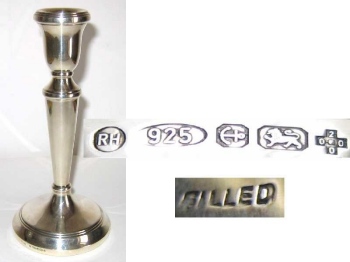 |
|
|
Queen Elisabeth II Golden Jubilee (spoon)
Maker BD Sheffield 2002.
The commemorative hallmark is the head of Queen Elisabeth II.
The spoon bears at its top the profile of Queen Elisabeth II and the motto of the
order of
Garters "honi soit qui mal y pense" (French for "Evil be to him who evil
thinks" ENDNOTE 2). The foundation of this order was attributed to King Edward III
in the early fourteenth century, during a ceremony at the Windsor castle. Also impressed the
dates 1952 and 2002 for the Golden Jubilee. Since 1999 la finesse mark for sterling silver is
the number 925 in an oval.
The "traditional marks" lion passant and date letter became optional after this date.
In this case the lion passant was struck but the date letter omitted. The hallmark of the Sheffield
Assay Office is the "Tudor rose", which substituted the "crown" in 1975
Dimension and weight: 12 cm. 34 g
|
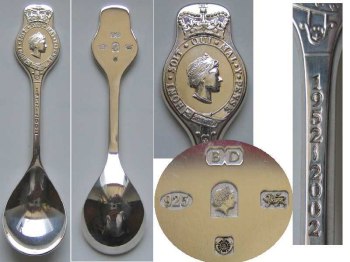 |
|
|
ENDNOTE 1: The first date letter used by Sheffield Assay Office at the date of its opening in
1773 was not an A but a gothic D. Contrary to the other main Assay Offices where the sequence of
the date letters followed an alphabetical order, Sheffield adopted a random sequence from 1773 to
1823.
ENDNOTE 2: The official language of the British Monarch in the middle age was the Norman French
year (1)
|
struck hallmark (2)
|
facsimile (3)
|
description
|
1934/35
1935/36
|
|
|
George V Silver Jubilee.
Profile of crowned George V and Queen Mary
|
1952/53
1953/54
|
|
|
Coronation of Queen Elisabeth II.
Profile of crowned Queen Elisabeth looking right in an oval punch.
|
1973/74
|
|
|
Bicentenary of the opening of the Birmingham Assay Office.
double C (two hundred in Roman numbers) at the sides of the anchor
|
1973/74
|
|
|
Bicentenary of the opening of the Sheffield Assay Office.
The same date letter used in 1773 (a capital gothic E)
|
1977
|
|
|
Elisabeth II Silver Jubilee
Profile of Queen Elisabeth looking left.
|
1999/2000
|
|
|
New Millennium
2,000 in a cross with a dot at its centre.
|
2002
|
|
|
Elisabeth II Golden Jubilee
Profile of Queen Elisabeth looking right in an arch shaped punch.
|
(1) the reported dates are those of the effective use of the hallmarks
(2) as found on real items.
(3) in the facsimile reproductions the relief (cameo) part is conventional in white and the incuse part of
the hallmark (including the field of the punch) is in black.
Part one of this article, dealing with Irish Silver
was published in November 2006 Newsletter
click here |
 ASSOCIATION OF SMALL COLLECTORS OF ANTIQUE SILVER
ASSOCIATION OF SMALL COLLECTORS OF ANTIQUE SILVER



































